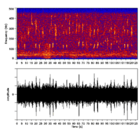Earth:Ultra-short baseline
USBL (ultra-short baseline, also sometimes known as SSBL for super short base line) is a method of underwater acoustic positioning. A complete USBL system consists of a transceiver, which is mounted on a pole under a ship, and a transponder or responder on the seafloor, on a towfish, or on an ROV. A computer, or "topside unit", is used to calculate a position from the ranges and bearings measured by the transceiver. An acoustic pulse is transmitted by the transceiver and detected by the subsea transponder, which replies with its own acoustic pulse. This return pulse is detected by the shipboard transceiver. The time from the transmission of the initial acoustic pulse until the reply is detected is measured by the USBL system and is converted into a range.
To calculate a subsea position, the USBL calculates both a range and an angle from the transceiver to the subsea beacon. Angles are measured by the transceiver, which contains an array of transducers. The transceiver head normally contains three or more transducers separated by a baseline of 10 cm or less. A method called “phase-differencing” within this transducer array is used to calculate the direction to the subsea transponder.
USBLs have also begun to find use in "inverted" (iUSBL) configurations, with the transceiver mounted on an autonomous underwater vehicle, and the transponder on the target. In this case, the "topside" processing happens inside the vehicle to allow it to locate the transponder for applications such as automatic docking and target tracking.
References
External links
- Product Survey USBL Systems Hydro International, May 2008.
Manufacturers
- EASYTRAK USBL Applied Acoustics
- IXBLUE - GAPS pre-calibrated Ultra-Short BaseLine -
- IXBLUE - POSIDONIA - Ultra-deep & long range Ultra-Short Baseline -
- Nautronix USBL
- TrackLink USBL - LinkQuest
- Tritech International Ltd
- Sonardyne Ranger 2 and Scout USBLs
- Kongsberg Acoustic Positioning
- EvoLogics USBL Modems
- Zima USBL Underwater communiation & navigation laboratory


